Poinsettia Primer
Keep the holiday flower power strong for next year
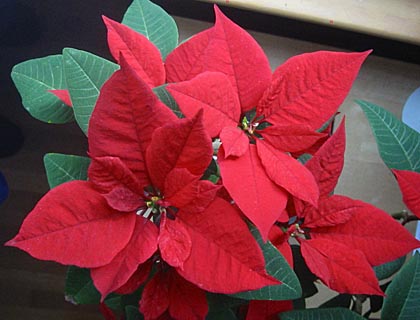
My poinsettia reblooming in second year
Just about everyone loves poinsettias at holiday time. But too often, this popular plant ends its days in the garbage bin sometime in midwinter. It is a sad fate for a plant that not only has a rich and interesting history, but for one that, with a little patience on the gardener’s part, is easily coaxed into rebloom.
The poinsettia (Euphorbia pulcherrima) is the best-selling potted plant in America. It is a euphorbia and a member of the spurge family. Like other members of this family, it has a milky sap. This has led to the belief that the plant is poisonous, although university research shows this to be untrue. The American Medical Association’s handbooks, however, note that ingesting parts of the poinsettia plant may occasionally cause vomiting.
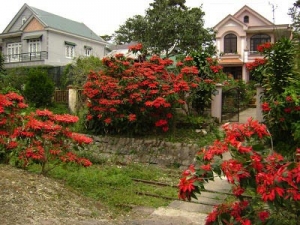
Growing full-size outdoors
But the plant’s history goes back further. Aztecs used the red leaves to make a dye and the white sap as a medicinal cure for fever. Montezuma, the last Aztec king, had the plants brought into his capital city (what is now Mexico City) because the poinsettia was not grown in the city’s high altitude.
Poinsettias are native to Central America, growing in the wild as shrubs or small trees that can reach heights of 10 to 12 feet. The red blooms are actually flower bracts and leaves — not flower petals. The small, yellow cyathium found in the center is the actual flower and is typical of euphorbias.
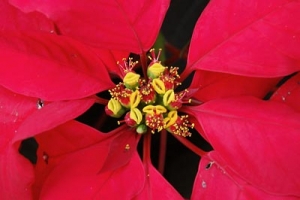
Real flowers are small & yellow
No matter what the cultivar, poinsettias do not like cold weather. Exposure to cold can damage the blooms and leaves. The plants prefer daytime temperatures of 60 to 70 degrees, with night temperatures no lower than 55 degrees. They also like bright light of up to six hours a day and moist, but not waterlogged, soil. Excess water will suffocate the root system.
Poinsettias will retain their beauty in the house for weeks after your holiday purchase, and thereafter, you can take steps to preserve them for bloom next year. When the red leaves begin to fade and deteriorate, cut the flowers off to about 8 inches from the soil and then give the plant a bit of fertilizer and more light. The plant should begin to produce new leaves. When the weather warms, place the poinsettia outdoors after transplanting it to a larger pot, and allow it to continue to grow.
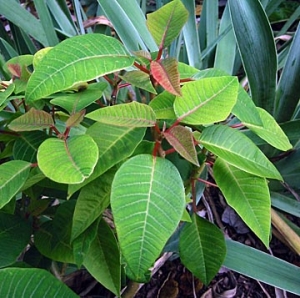
Starting to turn red outdoors in October
My own experience getting a poinsettia to rebloom was relatively easy. I kept the plant outdoors during the summer, as a foliage plant, getting a little additional enjoyment for my money. Around mid-October, it began showing signs of red color in the leaf veins and leaf stems. At that point, before the frost came, I brought it indoors and moved it to a dark basement each night after coming home from work. By the holidays, it was blooming happily, saving me both from having to buy a fresh poinsettia and from the guilt I might have otherwise felt from tossing a perfectly good plant.
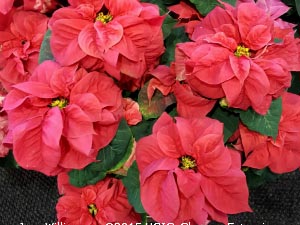 Winter Rose Dark Red | 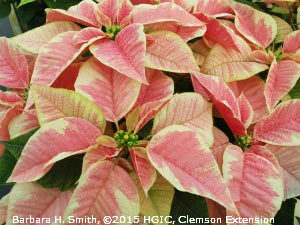 Peterstar Marble | 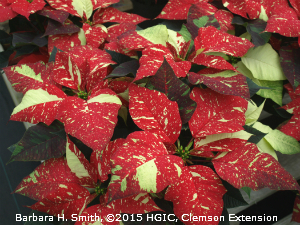 Red Glitter |
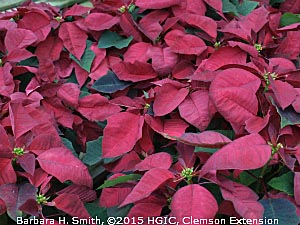 Corteze Burgundy | 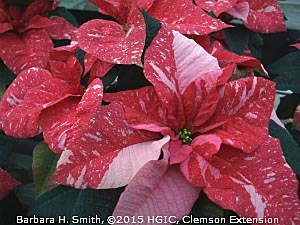 Jingle Bells | 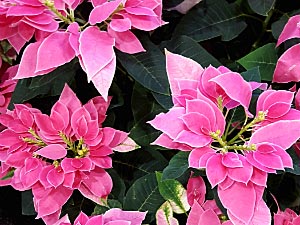 Luv U Pink |
References
How to Choose and Care for Your Poinsettia, Ohio State University Fact Sheet
Poinsettia, Clemson Cooperative Extension
The Poinsettia Pages, University of Illinois Extension